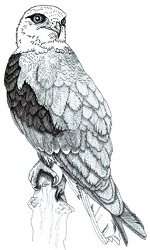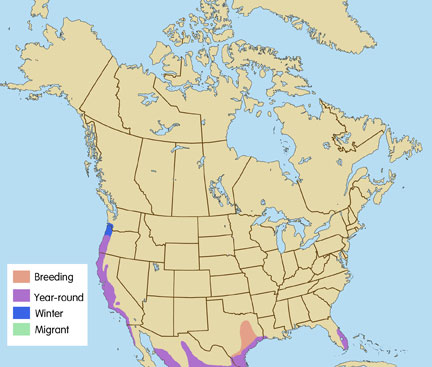
Scientific Name: Elanus leucurus
Not often confused with other raptors, the White-tailed kite can be identified in the field fairly easily. Small to medium in size, kites have long white tails with relatively long, thin and pointed wings. Wing and tail shape help them maintain a hovering position in the air. Adults are white underneath and gray on the back. Sexes are similar in size but the female may be darker on the back. While in flight a characteristic black spot can be seen at the bend of the underside of the wing. Their yellow legs are short, and their toes are stout. Adults have red eyes.
These small-bodied raptors are unique in their hover-hunting style. Rarely seen perch-hunting, like other raptors, these birds hover 5-25 meters off the ground, both early and late in the day. Facing into the wind, they scan back and forth for prey items; while also scanning side to side for predators and competitors. These hovers last between one second to less than one minute. Longer hovers have been recorded during windy conditions. The hover sessions end in either a dive to the ground with wings in a vertical position and feet extended out for prey or to another hover location. Sometimes, these hovers will also end in an interaction with another bird or the kite flying to a perch to end the hunting session.
Male/Female
Length: 12.5 – 15.0″
Wingspan: 40″
Weight: 10.8 – 12.2 oz.
During the early 20th century White-tailed kites were threatened with extinction in North America. However, populations recovered and the species even extended its range in the western United States. Habitat loss, beginning in the 1980’s, has once again threatened the White-tailed kite. This species is both state and federally protected.
Hover hunting requires open spaces. Habitats that are used by the white tailed kite include: low elevation grasslands, agricultural areas, wetlands and savannas.
White-tailed kites are small mammal specialists, with over 95% of their prey items consisting of rodents. Other items, such as lizards, birds and insects, are taken incidentally.
Most common call is a kewt, given singly or spaced by 1-2 seconds. Resembles an osprey call but is more whistle-like. Another common call is the eee-grack which sounds much like a frog call. Babies have a loud, raspy hunger call that is fairly insistent.
They are tree nesters and build stick nests, which can start fairly early in winter, soon after courtship – which can be as early as December. The nest building occurs slowly over the course of several weeks, and the nest is then lined with grass, weeds or leaves. Rigid territoriality is not seen in this species. During the breeding season pairs do protect an area from conspecifics; however, the size of this area depends on prey abundance and nest site availability. During the non-breeding season, kites can be found in small stands of trees communally roosting with more than 100 individuals. Usually, though, these communal roosts have between 10-40 individuals. Population density at these roost sites is limited by the abundance of prey in the area.
Relatively new to the Willamette Valley of Oregon, there has not yet been a White-tailed kite brought into care at the Cascades Raptor Center. Habitat is being lost to increased residential and commercial development of open areas in all western states and in Florida.

Breeds in North America in the states of Florida, Texas, Oregon and California. Most individuals are found in California. This species also breeds in Central and South America. Most individuals remain in their breeding range during the non-breeding season; however, the hunting area needed to support an individual may increase during the winter months. May be nomadic in winter if prey is base is very low.
Special Thanks for range maps:
Dan Gleason
BGleason Design & Illustration
Commercial & Scientific Illustration, Graphic Design
CraneDance Communications
Book Production/Design

